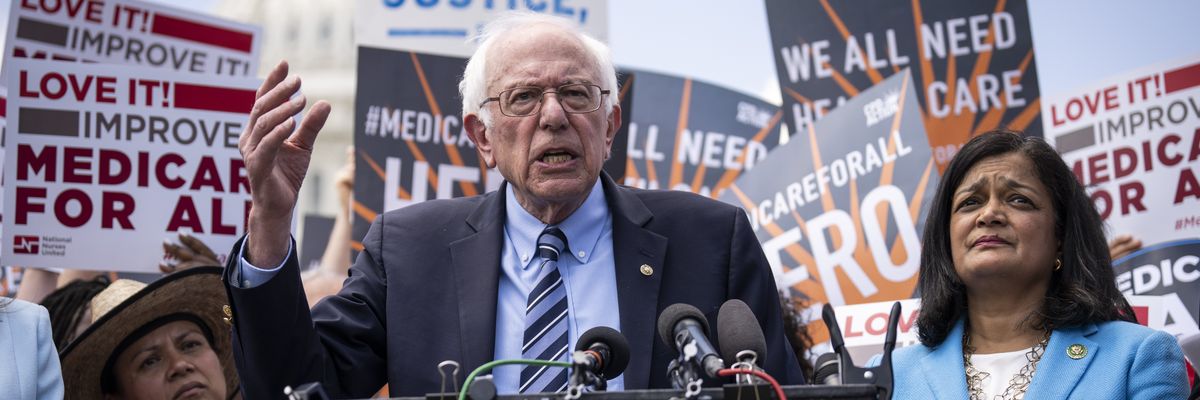
Sen. Bernie Sanders (I-Vt.) speaks alongside Rep. Pramila Jayapal (D-Wash.) during a news conference to announce the re-introduction of the Medicare For All Act of 2023, outside the U.S. Capitol on May 17, 2023 in Washington, D.C.
The Evidence Is Clear: Medicare for All Will Save Money and Lives
The only two peer-reviewed medical articles on the issue in the last 30 years came to the same conclusion: Medicare for All will save money, by removing unnecessary paperwork and insurance company profits, lowering drug costs, and other factors.
On Wednesday, Medicare for All legislation was introduced in the U.S. Senate and House, by Senator Bernie Sanders (I-Vt.) and Congresswoman Pramila Jayapal (D-Wash.). The bills use public financing to provide excellent insurance (including dental, vision, and long-term care) for everyone, with minimal cost-sharing.
A central question is affordability. Will Medicare for All raise or lower healthcare costs in the United States? Is it affordable?
We led two academic teams that published scientific papers to address this, the only peer-reviewed medical articles on this topic in the last 30 years. We worked separately, at Yale University and the University of California.
We think it’s time to retire doubts about the net cost of single payer or Medicare for All. The evidence for big savings is real.
We came to the same conclusion: Yes, Medicare for All will save money, by removing unnecessary paperwork and insurance company profits, lowering drug costs, and other factors. These savings will more than offset the cost of improving coverage and expanding it to everyone.
In the University of California review we found that 19 of 22 past analyses of single-payer or Medicare-for-All plans, from 1990 to 2018, projected net savings in year one. The median expected savings was 3.5%. That equals $120 billion in net savings for the U.S., with increases over time due to controls on spending growth. The exact savings varied across studies due to differences in anticipated reductions in paperwork and drug costs.
In the Yale study, using the latest available data to create a new analysis, we estimated that the Sanders bill would save more than $450 billion per year (13% of all health spending) while preventing tens of thousands of deaths compared with the status quo. In addition, the quality and productivity of our lives will be improved by Medicare for All.
What does it mean that these two studies came to the same basic conclusion?
- Single-payer (like Medicare for All) is and has always been about simplifying how we pay for health care, using a single public agency. This yields massive savings in billing paperwork, plus negotiated lower drug and equipment prices, as well as fair physician reimbursement, and potential fraud and waste reduction.
- The Medicare-for-All bills builds on this single-payer history, using the same basic approaches, so it’s unsurprising that the results are similar.
- The findings of net savings are “robust.” That’s geek-speak meaning there’s room for uncertainty, but net savings are still predicted. For example, what if savings on paperwork aren’t quite as great? Or drug costs don’t drop as much as hoped? Some of this uncertainty is about not having a perfect crystal ball. And some is about policy choices–what will the final Medicare for All bill look like? That’s up to the policymakers (and us!). Regardless, there would be net savings.
The Congressional Budget Office also estimated net savings from single payer.
What's the difference between these studies, which conclude that single payer would save money, and other studies that conclude it would not?
- First, the Yale and University of California, San Francisco (UCSF) studies are peer-reviewed, which means that the reports were closely examined by experts in the field for validity, and refinements implemented to satisfy the reviewers and editor. Other studies were not subject to this rigorous scrutiny.
- Second, the Yale and UCSF studies are based on a strict definition of what makes a healthcare financing system “single-payer.” Some studies purporting to be about single-payer include private insurers and their added costs in their calculations.
- Third, the Yale and UCSF researchers do not stand to profit from the outcome. They are academics, not consultants paid by clients with strong political and policy priorities.
By the way, these net savings are underestimated. None of these studies, not even the most recent one, had access to new evidence suggesting that universal coverage expansions have historically led to modest or even zero increases in healthcare use. The newly covered individuals use more health care, to be sure, but at the same time, doctors provide a bit less unnecessary care to the well-off and well-insured. This means that overall increases are minimal, and universal coverage adds less cost.
How should this evidence change the discussion?
We think it’s time to retire doubts about the net cost of single-payer or Medicare for All. The evidence for big savings is real.
Here’s the headline: Medicare for All saves both money and lives. It’s a no-brainer.
An Urgent Message From Our Co-Founder
Dear Common Dreams reader, The U.S. is on a fast track to authoritarianism like nothing I've ever seen. Meanwhile, corporate news outlets are utterly capitulating to Trump, twisting their coverage to avoid drawing his ire while lining up to stuff cash in his pockets. That's why I believe that Common Dreams is doing the best and most consequential reporting that we've ever done. Our small but mighty team is a progressive reporting powerhouse, covering the news every day that the corporate media never will. Our mission has always been simple: To inform. To inspire. And to ignite change for the common good. Now here's the key piece that I want all our readers to understand: None of this would be possible without your financial support. That's not just some fundraising cliche. It's the absolute and literal truth. We don't accept corporate advertising and never will. We don't have a paywall because we don't think people should be blocked from critical news based on their ability to pay. Everything we do is funded by the donations of readers like you. Will you donate now to help power the nonprofit, independent reporting of Common Dreams? Thank you for being a vital member of our community. Together, we can keep independent journalism alive when it’s needed most. - Craig Brown, Co-founder |
On Wednesday, Medicare for All legislation was introduced in the U.S. Senate and House, by Senator Bernie Sanders (I-Vt.) and Congresswoman Pramila Jayapal (D-Wash.). The bills use public financing to provide excellent insurance (including dental, vision, and long-term care) for everyone, with minimal cost-sharing.
A central question is affordability. Will Medicare for All raise or lower healthcare costs in the United States? Is it affordable?
We led two academic teams that published scientific papers to address this, the only peer-reviewed medical articles on this topic in the last 30 years. We worked separately, at Yale University and the University of California.
We think it’s time to retire doubts about the net cost of single payer or Medicare for All. The evidence for big savings is real.
We came to the same conclusion: Yes, Medicare for All will save money, by removing unnecessary paperwork and insurance company profits, lowering drug costs, and other factors. These savings will more than offset the cost of improving coverage and expanding it to everyone.
In the University of California review we found that 19 of 22 past analyses of single-payer or Medicare-for-All plans, from 1990 to 2018, projected net savings in year one. The median expected savings was 3.5%. That equals $120 billion in net savings for the U.S., with increases over time due to controls on spending growth. The exact savings varied across studies due to differences in anticipated reductions in paperwork and drug costs.
In the Yale study, using the latest available data to create a new analysis, we estimated that the Sanders bill would save more than $450 billion per year (13% of all health spending) while preventing tens of thousands of deaths compared with the status quo. In addition, the quality and productivity of our lives will be improved by Medicare for All.
What does it mean that these two studies came to the same basic conclusion?
- Single-payer (like Medicare for All) is and has always been about simplifying how we pay for health care, using a single public agency. This yields massive savings in billing paperwork, plus negotiated lower drug and equipment prices, as well as fair physician reimbursement, and potential fraud and waste reduction.
- The Medicare-for-All bills builds on this single-payer history, using the same basic approaches, so it’s unsurprising that the results are similar.
- The findings of net savings are “robust.” That’s geek-speak meaning there’s room for uncertainty, but net savings are still predicted. For example, what if savings on paperwork aren’t quite as great? Or drug costs don’t drop as much as hoped? Some of this uncertainty is about not having a perfect crystal ball. And some is about policy choices–what will the final Medicare for All bill look like? That’s up to the policymakers (and us!). Regardless, there would be net savings.
The Congressional Budget Office also estimated net savings from single payer.
What's the difference between these studies, which conclude that single payer would save money, and other studies that conclude it would not?
- First, the Yale and University of California, San Francisco (UCSF) studies are peer-reviewed, which means that the reports were closely examined by experts in the field for validity, and refinements implemented to satisfy the reviewers and editor. Other studies were not subject to this rigorous scrutiny.
- Second, the Yale and UCSF studies are based on a strict definition of what makes a healthcare financing system “single-payer.” Some studies purporting to be about single-payer include private insurers and their added costs in their calculations.
- Third, the Yale and UCSF researchers do not stand to profit from the outcome. They are academics, not consultants paid by clients with strong political and policy priorities.
By the way, these net savings are underestimated. None of these studies, not even the most recent one, had access to new evidence suggesting that universal coverage expansions have historically led to modest or even zero increases in healthcare use. The newly covered individuals use more health care, to be sure, but at the same time, doctors provide a bit less unnecessary care to the well-off and well-insured. This means that overall increases are minimal, and universal coverage adds less cost.
How should this evidence change the discussion?
We think it’s time to retire doubts about the net cost of single-payer or Medicare for All. The evidence for big savings is real.
Here’s the headline: Medicare for All saves both money and lives. It’s a no-brainer.
- Corporate Media Are Here to Warn You: Medicare for All Is a Very Bad Idea ›
- Sanders Applauds New Medicare for All Study: Will Save Americans $450 Billion and Prevent 68,000 Unnecessary Deaths Every Year ›
- Health Cost Calculator Shows Most Californians Would Save Big With Medicare for All ›
- Opinion | Single-Payer Healthcare Would Save Money and Lives | Common Dreams ›
On Wednesday, Medicare for All legislation was introduced in the U.S. Senate and House, by Senator Bernie Sanders (I-Vt.) and Congresswoman Pramila Jayapal (D-Wash.). The bills use public financing to provide excellent insurance (including dental, vision, and long-term care) for everyone, with minimal cost-sharing.
A central question is affordability. Will Medicare for All raise or lower healthcare costs in the United States? Is it affordable?
We led two academic teams that published scientific papers to address this, the only peer-reviewed medical articles on this topic in the last 30 years. We worked separately, at Yale University and the University of California.
We think it’s time to retire doubts about the net cost of single payer or Medicare for All. The evidence for big savings is real.
We came to the same conclusion: Yes, Medicare for All will save money, by removing unnecessary paperwork and insurance company profits, lowering drug costs, and other factors. These savings will more than offset the cost of improving coverage and expanding it to everyone.
In the University of California review we found that 19 of 22 past analyses of single-payer or Medicare-for-All plans, from 1990 to 2018, projected net savings in year one. The median expected savings was 3.5%. That equals $120 billion in net savings for the U.S., with increases over time due to controls on spending growth. The exact savings varied across studies due to differences in anticipated reductions in paperwork and drug costs.
In the Yale study, using the latest available data to create a new analysis, we estimated that the Sanders bill would save more than $450 billion per year (13% of all health spending) while preventing tens of thousands of deaths compared with the status quo. In addition, the quality and productivity of our lives will be improved by Medicare for All.
What does it mean that these two studies came to the same basic conclusion?
- Single-payer (like Medicare for All) is and has always been about simplifying how we pay for health care, using a single public agency. This yields massive savings in billing paperwork, plus negotiated lower drug and equipment prices, as well as fair physician reimbursement, and potential fraud and waste reduction.
- The Medicare-for-All bills builds on this single-payer history, using the same basic approaches, so it’s unsurprising that the results are similar.
- The findings of net savings are “robust.” That’s geek-speak meaning there’s room for uncertainty, but net savings are still predicted. For example, what if savings on paperwork aren’t quite as great? Or drug costs don’t drop as much as hoped? Some of this uncertainty is about not having a perfect crystal ball. And some is about policy choices–what will the final Medicare for All bill look like? That’s up to the policymakers (and us!). Regardless, there would be net savings.
The Congressional Budget Office also estimated net savings from single payer.
What's the difference between these studies, which conclude that single payer would save money, and other studies that conclude it would not?
- First, the Yale and University of California, San Francisco (UCSF) studies are peer-reviewed, which means that the reports were closely examined by experts in the field for validity, and refinements implemented to satisfy the reviewers and editor. Other studies were not subject to this rigorous scrutiny.
- Second, the Yale and UCSF studies are based on a strict definition of what makes a healthcare financing system “single-payer.” Some studies purporting to be about single-payer include private insurers and their added costs in their calculations.
- Third, the Yale and UCSF researchers do not stand to profit from the outcome. They are academics, not consultants paid by clients with strong political and policy priorities.
By the way, these net savings are underestimated. None of these studies, not even the most recent one, had access to new evidence suggesting that universal coverage expansions have historically led to modest or even zero increases in healthcare use. The newly covered individuals use more health care, to be sure, but at the same time, doctors provide a bit less unnecessary care to the well-off and well-insured. This means that overall increases are minimal, and universal coverage adds less cost.
How should this evidence change the discussion?
We think it’s time to retire doubts about the net cost of single-payer or Medicare for All. The evidence for big savings is real.
Here’s the headline: Medicare for All saves both money and lives. It’s a no-brainer.
- Corporate Media Are Here to Warn You: Medicare for All Is a Very Bad Idea ›
- Sanders Applauds New Medicare for All Study: Will Save Americans $450 Billion and Prevent 68,000 Unnecessary Deaths Every Year ›
- Health Cost Calculator Shows Most Californians Would Save Big With Medicare for All ›
- Opinion | Single-Payer Healthcare Would Save Money and Lives | Common Dreams ›

